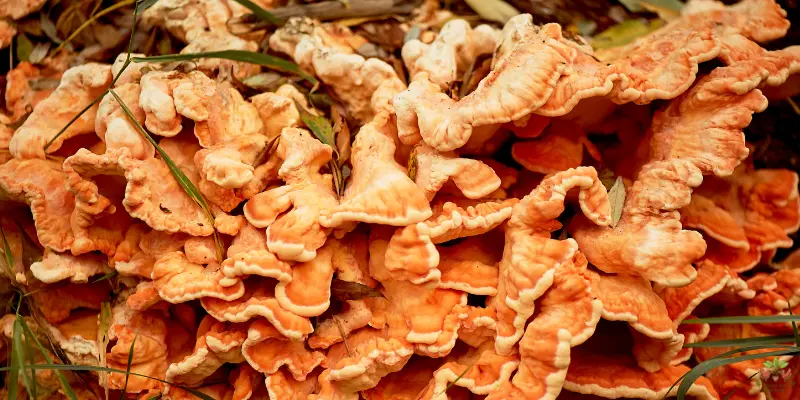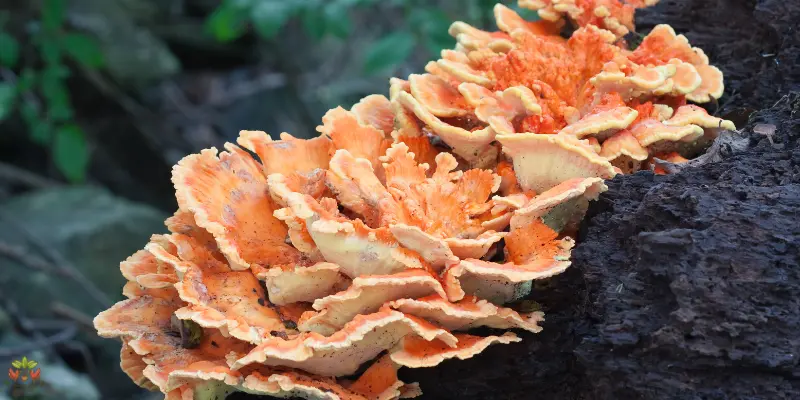To get rid of pink fungus in the garden, apply a fungicide in the fall to prevent its development and kill it while it’s dormant. Additionally, physically removing the fungus from the mulch is another effective method.
Pink fungus in the garden can be a common issue caused by factors such as high organic matter in the soil. While it may not be harmful, it can be unsightly and undesirable. Chemical treatments are not recommended for pink fungus, so using natural methods is the best approach.
By taking preventive measures like applying fungicides and properly maintaining the garden, you can effectively control and eliminate pink fungus.
Table of Contents
Understanding Pink Fungus In The Garden
Discover the ins and outs of pink fungus in your garden, including effective methods to eliminate it. Avoid the repetitive use of harsh chemicals with these helpful tips.
What Is Pink Fungus?
Pink fungus, also known as pink mold or pink slime, is a common type of fungus that can be found in gardens. It typically appears as a pink or reddish growth on plant leaves, stems, and even on the soil surface.
Causes Of Pink Fungus In The Garden
Pink fungus thrives in outdoor environments with high humidity and moist conditions. Here are some common causes of pink fungus in the garden:
- Excessive watering: Overwatering your plants can create a favorable environment for pink fungus to grow.
- Poor drainage: Soil that doesn’t drain well can lead to moisture buildup, providing an ideal breeding ground for pink fungus.
- Weakened plants: Plants that are stressed or weakened due to poor nutrition or disease are more susceptible to pink fungus infections.
- Poor air circulation: Lack of airflow around plants can contribute to increased humidity levels, promoting pink fungus growth.
Impacts Of Pink Fungus On Plants
Pink fungus can have detrimental effects on your garden plants. Here are some ways it can impact them:
If you notice pink fungus in your garden, it’s important to take action to control and eliminate it. In the next section, we’ll discuss effective methods to get rid of pink fungus in your garden.

Identifying And Managing Pink Fungus In The Garden
Gardening enthusiasts know the importance of maintaining a healthy garden. However, one common problem that many gardeners face is the presence of pink fungus. Pink fungus, also known as pink mold, can be unsightly and detrimental to the health of your plants. In this article, we will discuss the signs and symptoms of pink fungus, methods to prevent its growth, and effective management techniques to get rid of it.
Signs And Symptoms Of Pink Fungus
Identifying pink fungus in your garden is crucial to effectively manage and eliminate it. Here are some key signs and symptoms to watch out for:
- Pink or reddish growth on the soil, plants, or mulch
- Presence of a slimy texture
- Foul odor emanating from affected areas
- Pink or reddish spores released into the air
Preventing The Growth Of Pink Fungus
Prevention is always better than cure when it comes to pink fungus in the garden. By implementing the following practices, you can reduce the chances of pink fungus taking hold in your garden:
Effective Management Techniques
If pink fungus does appear in your garden despite your preventive efforts, here are some effective management techniques to help you get rid of it:
| Technique | Instructions |
| Fungicide application | Apply a suitable fungicide according to the manufacturer’s instructions to eliminate pink fungus |
| Trim affected plant parts | Remove and destroy any plants or plant parts that are heavily infected with pink fungus |
| Improve soil drainage | Amend your soil with organic matter or create raised beds to improve drainage and reduce moisture accumulation |
| Practice crop rotation | Avoid planting susceptible plants in the same location year after year to break the cycle of pink fungus |
By identifying the signs and symptoms of pink fungus, preventing its growth, and implementing effective management techniques, you can successfully manage and eliminate pink fungus in your garden. Remember to regularly inspect your garden and take proactive measures to maintain its health.
Getting Rid Of Pink Fungus In The Garden
The presence of pink fungus in your garden can be an eyesore and may even pose a threat to the health of your plants. However, with the right approach and a bit of effort, you can successfully get rid of this pesky fungus. In this section, we will explore some effective methods for eliminating pink fungus in your garden.
Chemical Treatments For Pink Fungus
If you’re dealing with a severe pink fungus infestation and natural remedies alone are not proving effective, you may consider using chemical treatments as a more aggressive approach. Here are a few chemical options that can help eradicate pink fungus:
It’s important to note that chemical treatments should be used as a last resort, as they may have adverse effects on beneficial insects and other plants in your garden. Always follow the manufacturer’s instructions and take necessary precautions when using chemical products.
Natural Remedies For Pink Fungus Removal
If you prefer a more eco-friendly approach or want to avoid using chemical treatments, there are several natural remedies that can help you get rid of pink fungus. Here are some effective options:
- Pruning and removal: Start by pruning the affected parts of your plants and removing any fallen leaves or debris. This helps reduce the spread of fungus and allows better air circulation, discouraging fungal growth.
- Neem oil: Neem oil is a natural fungicide and insecticide that can effectively control pink fungus. Mix neem oil with water according to the instructions and spray it onto the affected plants.
- Baking soda spray: Create a solution by mixing baking soda with water and a few drops of dish soap. Spray this mixture on the affected areas to disrupt the growth of the fungus.
- Cornmeal: Applying cornmeal to the soil can help control fungal growth. Sprinkle a thin layer of cornmeal around the affected plants, and water lightly to activate its antifungal properties.
These natural remedies are safe for the environment and can be used as preventative measures as well. Regularly inspecting your garden and taking prompt action can help keep pink fungus at bay.
Maintaining A Fungus-free Garden
Prevention is key when it comes to maintaining a fungus-free garden. By following a few simple practices, you can significantly reduce the risk of pink fungus and other fungal infections:
- Proper watering: Avoid overwatering your plants, as excess moisture can create a favorable environment for fungal growth. Instead, water deeply but infrequently, allowing the soil to dry out between waterings.
- Adequate spacing: Plant your garden in a way that allows for good air circulation. Avoid overcrowding plants, as this can create a humid environment that encourages fungal infections.
- Clean garden tools: Regularly clean and disinfect your gardening tools, especially if you’ve been working with infected plants. This helps prevent the spread of fungal spores from one plant to another.
- Remove plant debris: Fallen leaves, dead plants, and other plant debris can harbor fungal spores. Regularly clean and remove these materials from your garden to minimize the risk of fungal infections.
By incorporating these practices into your gardening routine, you can create an environment that is less susceptible to pink fungus and maintain a healthy garden overall.
Frequently Asked Questions On Pink Fungus In The Garden And How To Get Rid Of It
How Do You Get Rid Of Pink Mold Permanently?
To get rid of pink mold permanently, mix equal parts white vinegar and dish soap in a spray bottle. Spray the affected area and scrub with a stiff brush. Let it sit for an hour before rinsing and drying. Hydrogen peroxide is also effective.
Apply a fungicide in the fall to prevent its growth.
Does White Vinegar Kill Pink Mold?
White vinegar is an effective solution for killing pink mold. Mix equal parts white vinegar and dish soap in a bottle. Spray the area with the pink mold and scrub with a stiff brush. Let it sit for an hour before rinsing and drying the area.
The pink mold should be completely gone.
How Do You Treat Pink Grass Fungus?
To treat pink grass fungus, apply a fungicide in the fall to prevent its development and kill it in its dormant stage. Additionally, physically remove any visible parts of the fungus from the mulch.
Does Hydrogen Peroxide Kill Pink Mold?
Hydrogen peroxide is a safe and effective solution for killing pink mold. It acts as a powerful oxidizer and can also remove stains.
Conclusion
To effectively get rid of pink fungus in your garden, it’s important to take action promptly. Begin by identifying the type of fungus and implementing relevant treatment methods. Whether it’s using a fungicide, practicing proper watering techniques, or improving soil conditions, there are various strategies to combat this issue.
Regularly monitor and maintain your garden to prevent recurrence. Prioritize the health of your plants and soil by providing adequate sunlight, proper drainage, and organic matter. By following these steps, you can successfully eliminate pink fungus and ensure a healthy garden environment.


![Terrifying Trend: Why Do Roosters Chase Humans? [2024]](https://plantsandchickens.com/wp-content/uploads/2024/02/why-do-roosters-chase-humans-4.webp)


Leave a Reply